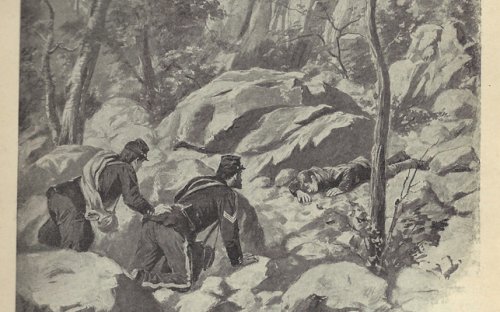Charles W. McKay was born on January 25, 1847 at Mansfield, Cattaraugus County and was working in a harness shop when he enlisted at Allegany on July 26, 1862. He was only 15 years of age, but fibbed that he was 18. He was mustered in as a Private in Company C of the 154th New York Volunteer Infantry on September 24, 1862, and was wounded in action on July 1, 1863, at the Battle of Gettysburg. He was promoted to Corporal on April 1, 1865, and to Sergeant on May 1, 1865. He was mustered out with his company on June 11, 1865, near Bladensburg, Maryland. McKay and his company comrade Stephen Welch (see below) were both issued the Medal of Honor on April 13, 1894, for a deed they performed on May 8, 1864, at the Battle of Dug Gap on Rocky Face Ridge, Georgia. Welch later described it for the book, Deeds of Valor, (which also included an illustration of the act): “On the 9th [sic] of May, 1864, the enemy was found in a strong position at a place called Rocky Face Ridge, near Dalton, Ga. In the afternoon the brigade was got in readiness for inspection of said ridge. A few of my company were detailed to act as skirmishers. We advanced slowly and cautiously, covering ourselves as best we could till we got within four rods of a perpendicular palisade crowning the top of the ridge. I found protection behind a rock, from which point I could occasionally see three or four of the enemy on top of the hill, and had a chance to discharge my gun in that direction. Meanwhile the brigade came up, our regiment on the right. They all went up to the perpendicular palisade of rock, some going up the crevices and to death. After about half an hour the bugler sounded a recall, and the brigade went down that hill much faster than it had gone up, but soon we got into proper order again. About this time the major came along and told me that he had seen a wounded soldier of my company, between the lines, adding that I had better get someone to help me go up and get him. Taking a tent-mate, Sergeant Charles W. McKay, we started out under a heavy fire, not only from the enemy, but also from our own lines. We found George Greek, a corporal of the color-guard, badly wounded in both legs. The poor fellow had been trying to drag himself along with his hands, and had sunk down, overcome by faintness and exhaustion. McKay revived him with a drink from his canteen, after which the corporal, raising himself on his elbow, asked if the colors were safe. We assured him that they were, and he dropped down again, satisfied and happy. We rolled him on a blanket, picked him up, and with bullets whizzing about us, managed to get him off the field.”
In the postwar years McKay worked for railroads. He died in Staples, Minnesota on August 25, 1912, and was buried in Oak Grove Cemetery in Fergus Falls, Minnesota.
Submitted by CAMP members.




